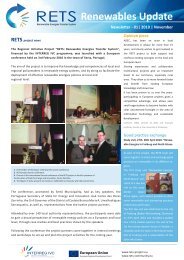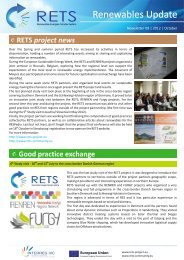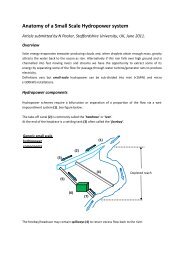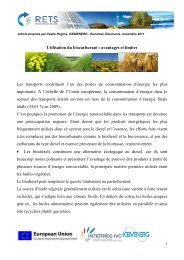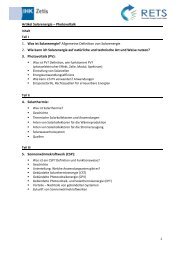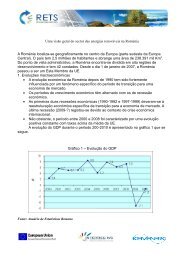Promoting renewable energies - RETS Project
Promoting renewable energies - RETS Project
Promoting renewable energies - RETS Project
You also want an ePaper? Increase the reach of your titles
YUMPU automatically turns print PDFs into web optimized ePapers that Google loves.
Solar Photovoltaic Technology<br />
Introduction<br />
Photovoltaic (PV) systems are silicon-based, solar<br />
energy to electricity converters. Overall performance<br />
depends on many factors including latitude, angle of<br />
collector, time of day and month, shading, climatic<br />
conditions and system conversion efficiency. The device<br />
produces direct current (DC) and electronic conversion to<br />
alternating current (AC) is facilitated by a device known<br />
as an inverter.<br />
Employment, market development and generating<br />
capacity<br />
The total cumulative installed capacity to date (2010)<br />
across Europe was reported as being in excess of 29,000<br />
MW peak with capacity leaders being Germany, Spain and<br />
Italy. The market development of this technology has<br />
been very much linked with the adoption of national<br />
<strong>renewable</strong> energy feed-in tariffs.<br />
It is estimated that employment linked with the<br />
manufacture and deployment of this technology across<br />
the EU is in excess of 268,000. In general countries at<br />
the top of the installed capacity league<br />
table have mirrored the technological<br />
roll-out with jobs.<br />
The market is valued at approximately<br />
€45,500 million.<br />
PV panels in Weinbourg, France<br />
EU resource assessment<br />
The potential for energy capture varies with latitude<br />
across the EU. For most countries with northerly<br />
latitudes, 1 kW peak of installed PV will produce around<br />
740 kWhe per year whilst for countries with more<br />
southern latitudes this could increase to over 1,400 kWh e<br />
per year.<br />
The EU commission’s forecast suggests that PV could<br />
provide 12% of European electricity demand by 2020.<br />
European countries with high solar irradiation and high<br />
electricity prices e.g. Spain, Italy are expected to have<br />
PV cost of electricity production at ‘grid parity’ by 2012<br />
and most other EU countries by 2020.<br />
Research, development and demonstration in the EU<br />
The key areas for PV research are:<br />
Improvements in efficiency and material<br />
intensities in current crystalline PV technologies;<br />
Improvements in efficiency and lifespan of thin<br />
film PV technologies;<br />
Development of third generation ultra-high<br />
efficiency, low cost novel technologies;<br />
New methods of grid management e.g. advanced<br />
communications and condition monitoring, to<br />
allow high levels of PV power in the system;<br />
Reducing ‘balance of system’ i.e. inverter,<br />
controller, isolator etc. costs.<br />
<strong>RETS</strong> Compendium – © 2012 <strong>RETS</strong> Consortium<br />
25




